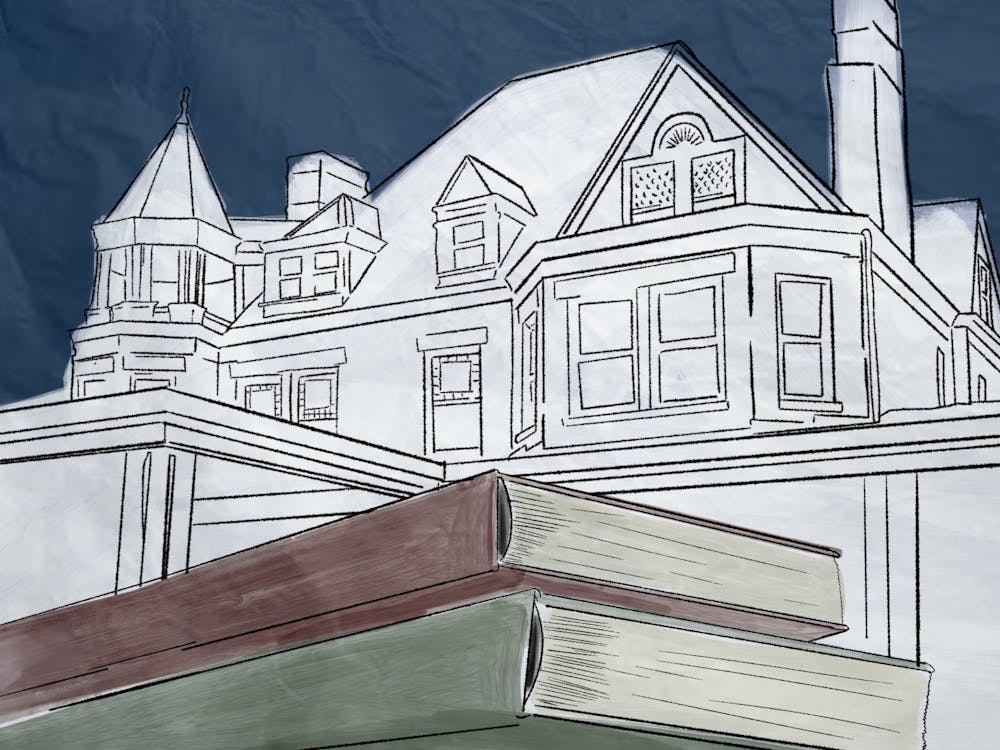“This needs to be a conversation, otherwise it isn’t going to work,” New Haven-based artist Titus Kaphar said as he began speaking to the lecture hall of the Special Collections Library during a University-sponsored event Tuesday. Questions and audience participation were more than welcome during Kaphar’s presentation, which made a large and relatively public space feel like an intimate setting.
Famed for re-examining representation and legacies in history through his work, Kaphar is known to crumple, strip, tear, disassemble and “torture” paintings and sculptures in a process of reconfiguration and interrogation of historical narratives. The subject matter is particularly potent in Charlottesville, a city still grappling with the violent white supremacist rally that took place in Aug. 2017 and a fraught racial history which is tied with the complex life of University founder and slaveholder Thomas Jefferson.
Kaphar described an art history class where his professor skipped over the few pages of their textbook that were dedicated to black painting. The ignorance frustrated Kaphar, who realized the necessity of writing “your own syllabus” if one hoped to represent an undervalued tradition. After enrolling in a performance art class he improvised a performance where he threw his art history book through a wall. The stunt taught him that “art has the ability to stop people in their tracks.”
Later at Yale’s School of Art, Kaphar again found himself in a culture that dismissed his specific style of painting. To him, painting and history were still very much the here and now.
“If painting’s dead, I’ll be the one to do the autopsy,” Kaphar said.
Growing frustrated while working on a painting depicting a couple, Kaphar shredded out the face of the woman with a razor blade, freeing her from what was historically documented as a troubled relationship. His act of frustration turned into a brilliant moment of creative inspiration. In “torturing the painting” he had given himself permission to explore painting in his own way, regardless of what the ego-centric professors at Yale had to say when evaluating his work.
His style developed in paintings like “Striped” (2014) and “Shred of Truth” (2017), in which Kaphar took historical replicas of historical figures’ oil painting representations like Andrew Jackson and tore up sections into thin stripes suspended beyond the canvas with nails. The inspiration came from asking, “What’s canon?” and working to re-establish glorified views of individuals more flawed and complex than history textbooks and traditional education would suggest.
Kaphar wants audiences to look beyond traditional legacies and explore suppressed histories. This motif is established in the dramatically affecting “Twisted Tropes” (2016), which crumples up the majority of an oil-canvas to instead focus on the intact — and now highlighted — portrayal of a young, black child, previously withdrawn to the backdrop of a painting intended to put white subjects first.
“Behind the Myth of Benevolence” (2014) is even more aggressive with its reclaiming of a deprived narrative, peeling away a portrait of Thomas Jefferson to reveal a figure that stands simultaneously for Sally Hemings and black women overshadowed by white men as a whole. Kaphar cites his inspiration to a conversation with a white friend in which he challenged his friend’s assertion that Jefferson was “a benevolent slave owner.”
“How can benevolence and slavery be part of the same sentence?” the artist asked as he described the complicated personality and irony at the heart of Jefferson’s character. The whole auditorium felt the local resonance, sitting in the middle of Jefferson’s noble and liberty-focused academic vision built by enslaved laborers.
Kaphar’s reclaiming of history is not an abstract pursuit, but what he argues is a deeply personal one instead.
“I can’t bring myself to do it if I don’t have a personal connection to it,” he said.
“Yet Another Fight for Remembrance” (2014) depicts white lines covering the figures of protestors in Ferguson, Missouri, but to Kaphar the painting is about the black experience. It speaks to a harmful message in America which says, “Your citizenship is not valued like everyone else’s citizenship.”
The ambitious “Jerome Project” (2011) is a series of painting done by Kaphar of 99 incarcerated men sharing the first and family names of his biological father, who had also served time in prison. Their presence tackles systemic issues of racial injustice, including drug epidemics and the prison-industrial complex. He described the powerful depictions — painted in classically religious, iconographic forms — as “devotional style paintings of people we’re not devoted to.”
Beginning in 2016, as debates around Confederate statues gained national attention, Kaphar sought to remove hate from the pedestal and challenge it directly in “Monumental Inversions,” a series of statues and sculptures questioning dated ideologies of hatred.
He recalled the inspiration to a museum trip where one of his children asked “Why does that guy get to ride?” in reference to a man on horseback alongside two walking men. The innocent question proved surprisingly deep and thought-provoking and led Kaphar to try to work out a way to de-emphasize “monuments that no longer show our values” without participating in the tired and binary debate over leaving them in place or tearing them down.
“You all [here in Charlottesville] know about it better than anybody else,” Kaphar said.
Choosing between leaving monuments that represent hate up on pedestals or erasing them entirely is missing the point, argued Kaphar, who said, “we can’t pretend like it didn’t happen.”
He proposed taking monuments off pedestals and addressing them with artwork by contemporary artists meant to challenge them on an equal playing field, suggesting perhaps a modern version of the job-spurring Works Progress Administration which generated a myriad of public projects to make the new work.
In “Impressions of Liberty” (2017), Kaphar used the wood from a sycamore tree under which slaves were auctioned to make a sculpture. The piece includes a bust of Samuel Finley and portraits of an African-American family etched in glass beneath it. The complex and multi-layered arrangement has a deliberately confusing effect.
“We have to struggle to see both things at the same time,” said Kaphar.
Since 2015, Kaphar has worked on a project particularly personal to him — “NXTHVN” — a neighborhood art-development effort located in the underfunded New Haven area just outside of the Yale campus.
“This looks like home to me,” he said, emphasizing the need to cultivate a new generation of artists in deindustrialized and impoverished communities with the support which was not available when he was growing up.
The approach seeks to combine artistic fellowship and paid apprentice programs with practical concerns — like understanding the business of art — in order to make money in the world outside of an art school bubble. Kaphar wants to make pursuing a career in art a reality to people traditionally deprived of it.
“It’s unfair to pretend like you’re not paying the tuition you’re paying,” he said in reference to traditional art schools which dismiss business and finance.
Kaphar concluded his lecture by reiterating that all of his art is tied by a common theme, which requires participants to examine the whole narrative of history and not be afraid to personally be involved in it if they hope to challenge and reinvent it.
“I hope you see how it’s all connected,” Kaphar concluded.





